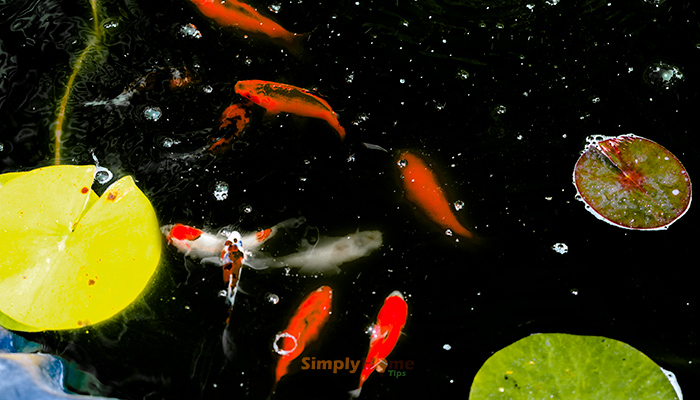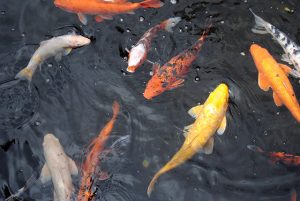“No human being, however great or powerful was ever so free as a fish” (John Ruskin). Having a pet fish is great for individuals who don’t have time to take care of larger mammals with higher maintenance. In addition, fish can appear in a range of colors, sizes, and shapes.

A great place to care for fish would be an outdoor garden pond. An outdoor pond is a mini aquarium where diverse fishes can exist happily in an open environment.
Best Fishes For Garden Patio Ponds
1. Comets Goldfish

- Maturity Size: 12″
- Lifespan: 15 years
- Best for ponds: Small to Large
The Comet Goldfish, Carassius Auratus, are known for their long flowing golden tail and are smaller than the average goldfish. Comet Goldfish come in a mixed variety of colors such as red, orange, yellow, and white.
These fish have been around since the 1800s through a selective breeding program created by Hugo Mulertt. Comets have the longevity of 15 years and grow to a maximum of 12 inches.
Because Comet Goldfish are active breeds of goldfish, they explore their vicinity and remember the environment inside Outdoor Garden Ponds.
2. Koi

- Maturity Size: 36″
- Lifespan: 40 Years
- Best for ponds: Medium to large
Koi Fishes, Cyprinus carpio, are known to be colorful versions of carp and breed from Japan. Koi are native to fresh bodies of water within the Black, Caspian, and Aral Seas. Domestication of carp fish dates back hundreds of years in 4th century China.
The biggest size of koi fish can grow is 3 feet. In addition, Koi fish has a lifespan of 40 years. They can inhabit multiple bodies of water which includes freshwater and saltwater. These fish have a high-temperature tolerance as long as the change in temperatures is gradual.
3. Shubunkin
- Maturity Size: 10″
- Lifespan: 15-25 years
- Best for ponds: Small, Medium, Large
Shubunkin fish are a breed of goldfish that originates from China. Shubunkin is composed of the colors: red, yellow, orange, blue, white, and black. These colors are speckled across its scales displaying an appealing sight. Shubunkin grows to an average of 6 – 10 inches.
Shubunkin lives about a maximum of 15 – 25 years when given the upmost care. These fish feed on insects and easily digestible fish feed.
4. High-Fin Banded Shark
- Maturity Size: 50″
- Lifespan: 25 years
- Best for ponds: Medium or large
High-Fin Banded Sharks, Myxocyprinus asiaticus, are black and white fish with a triangular dorsal fin. As these bottom-dwelling fish age, they grow to be 24 inches long during the life span of five to six years. In addition, these fish take on a crimson color if they are male or purple if they are female.
High-Fin Banded Sharks are omnivores even though their diet is consumed with heavy amounts of algae. High-Fin Banded Sharks can feed on earthworms, brine shrimp, and insects.
5. Pumpkin Seeds Sunfish
- Maturity Size: 4 to 6 inches
- Lifespan: 8 years
- Best for ponds: Small, Medium
The Pumpkinseed Sunfish, Lepomis Gibbosus, originates in southern Canada, along the eastern coast of the United States. These fishes earned their name from their pumpkin seed appearance.
Pumpkinseeds are colorful fish dappled with gold, orange, blue and green scales. An average Pumpkinseed is about 4 inches long and can grow to be 16 inches long. These omnivores live in freshwater and are accustomed to cool climates.
6. Pond Sturgeon
- Maturity Size: 50″
- Lifespan: 50 to 100 years
- Best for ponds: Medium, Large
The Pond Sturgeon, Acipenseridae, are prehistoric large fish that can grow up to a meter long. Over the last 250 million years, sturgeons have evolved as living dinosaurs due to their resemblance to historical fossils.
These fish reside in dark habitats with temperatures ranging from above freezing to below 22° C. They feed on shellfish, crabs, and barnacles.
Adjusting To A New Home
Various fishes can live in an outdoor garden pond. However, there is an adjusting period that each fish has go through. A great option is to keep the freshly purchased fish in its bag. Let the fishes along with their bag floats for 30 minutes or so. This will allow the fish to adjust to a different environment once officially released into the pond.
In addition to that, provide the garden pond with a number of hiding places for the fish. It will serve as protection from the scorching sun and flying predators.
Leave a Reply